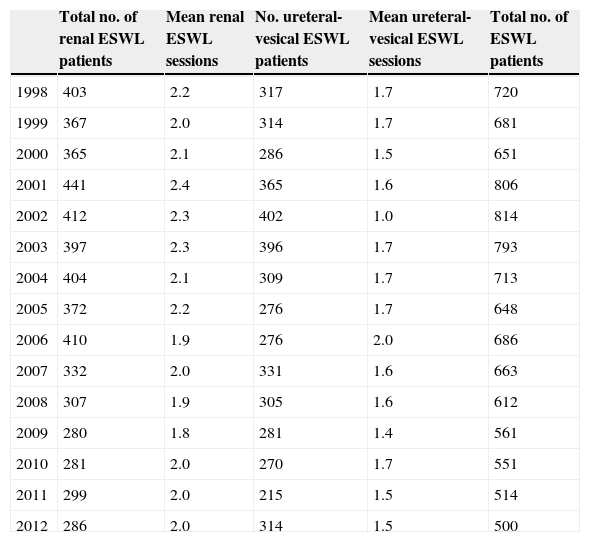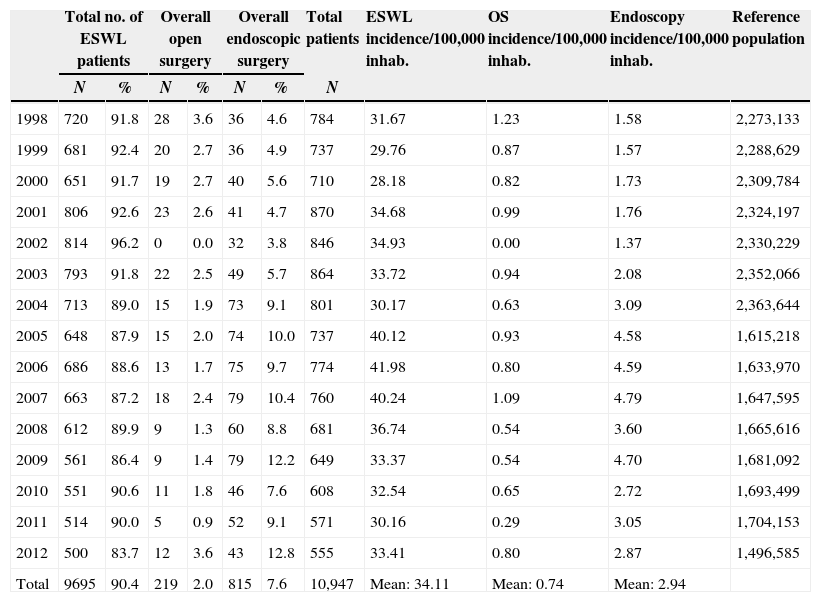In the following study, we observe the progress of various invasive calculi treatments that have taken place in our hospital in the last 15 years.
Materials and methodsWe extracted data from our hospital database on patients who underwent extracorporeal shock wave lithotripsy (ESWL), endoscopic surgery and open surgery. We analyzed how the incidence of these treatments has evolved over the last 15 years. We also studied the number of publications in PubMed that reference invasive calculi treatments.
ResultsFrom January 1998 to December 2012, a total of 10,947 patients were treated instrumentally for lithiasis, 9695 of whom (90.4%) underwent ESWL and 1034 of whom underwent endoscopic or open surgery (9.6%). The incidence of lithotripsy treatments reached its maximum in 2006, with a progressive reduction thereafter. The incidence of endoscopic surgery increased progressively until 2009 and then leveled off. We can see how in recent years there has been a clear increase in the number of studies that have covered endoscopic surgery, with a decreasing number covering ESWL.
ConclusionsIn our community, ESWL remains the most widely used invasive treatment for calculi. In recent years, there has been a reduction in the number of ESWL treatments and an increase in the number of endoscopic treatments, with open surgery showing a clearly decreasing trend.
En el siguiente trabajo se revisa la evolución de los diferentes tratamientos invasivos de la litiasis que se ha producido en nuestro hospital en los últimos 15 años.
Material y métodoSe han extraído de la base de datos de nuestro hospital los pacientes intervenidos de litotricia extracorpórea por ondas de choque (LEOC), de cirugía endoscópica y de cirugía abierta y se ha analizado cómo ha evolucionado la incidencia de estos tratamientos en los últimos 15 años. Así mismo se ha estudiado el número de publicaciones en PubMed que hacen referencia a los tratamientos invasivos de la litiasis.
ResultadosDesde enero de 1998 hasta diciembre de 2012 se han tratado instrumentalmente de litiasis un total de 10.947 pacientes, 9.695 pacientes (90,4%) de LEOC y 1.034 pacientes de cirugía (9,6%), endoscópica o abierta. La incidencia de tratamientos con litotricia ha tenido su máximo en 2006, presentando posteriormente una disminución progresiva. La incidencia de la cirugía endoscópica ha aumentado progresivamente hasta 2009 para luego mantenerse. Vemos cómo en los últimos años existe un aumento claro de los artículos que tratan de cirugía endoscópica, disminuyendo los trabajos de LEOC.
ConclusionesLa LEOC sigue siendo en nuestro medio el tratamiento invasivo para la litiasis más empleado. En los últimos años ha habido una disminución de los tratamientos de LEOC y un aumento de los tratamientos endoscópicos, presentando la cirugía abierta una clara tendencia a la baja.
Artículo
Comprando el artículo el PDF del mismo podrá ser descargado
Precio 19,34 €
Comprar ahora











